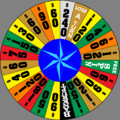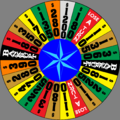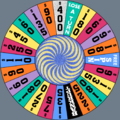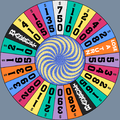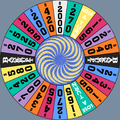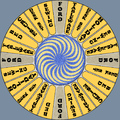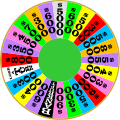- Wheel of Fortune (Australian game show)
-
This article is about Wheel of Fortune (Australian game show). For other uses, see Wheel of Fortune (disambiguation).
Wheel of Fortune 
Wheel of Fortune logoFormat Game show Created by Merv Griffin Presented by See Presenters Country of origin Australia Language(s) English No. of seasons 26 No. of episodes 5118 Production Location(s) Adelaide, South Australia (1981-1996)
Epping, Sydney, New South Wales (1996-2004)
Pyrmont, Sydney, New South Wales (Late 2005-2006)
Richmond, Melbourne, Victoria (2008)Running time 25 minutes Broadcast Original channel Seven Network (1981-2006)
Nine Network (2008)Picture format 576i (SDTV)
1080i (HDTV)Audio format Stereo Original run 21 July 1981 – 27 June 2008 Chronology Followed by Million Dollar Wheel of Fortune (2008, broadcast on the Nine Network) Related shows Wheel of Fortune (U.S. game show) Wheel of Fortune was an Australian television game show produced by Grundy Television. The programme aired on the Seven Network from 1981 to 2004 and November 2005 to July 2006, and is mostly based on the same general format as the original US version of the programme. After Wheel of Fortune ended, the format was revived by the Nine Network in 2008 as Million Dollar Wheel of Fortune, until it was canceled in June 2008 due to low ratings following arguments from long-time host John Burgess concerning why he didn't like the show.
An earlier unrelated show also titled Wheel of Fortune had been broadcast on the Nine Network. That version had been developed by Reg Grundy as a radio game show before it transferred to television in 1959.
Contents
History
In 1981, the Reg Grundy Organisation purchased the rights to Merv Griffin's U.S. game show Wheel of Fortune and promptly created a very faithful reproduction of the American series, as they had done with many other game shows. The new show began airing on the Seven Network on 21 July 1981, and was produced from ADS-7. The show's production moved to SAS-7 when ADS-7 and SAS-10 swapped callsigns and network affiliations at the end of 1987. In 1996, Wheel of Fortune relocated to ATN-7, where it remained until the series' cancellation in 2006.
As part of an attempted major revamp with the remaining of the show's very famous theme music and sounds, the program relocated from Adelaide to the Seven Network's Sydney studios. Along with a new set, new music, faster game format and modified rules, John Burgess was sacked from his twelve-year stint as host and replaced by Tony Barber. By the time that Burgess' final episode went to air, it had become common knowledge that the show had relocated and that changes would occur. A sign that drama would follow came at the end of Burgess' last episode on 12 July 1996, when he stated that the show was moving to Sydney, that it would still be exactly the same despite a new location and, that "Not everyone is coming with us to Sydney, and we are going to miss a lot of people."
The following Monday after Burgess' final episode, Tony Barber began as host, amid much controversy. Beside the fact that viewers did not appreciate the fact that Burgess was sacked without a chance to say his goodbyes on air, viewers had trouble accepting the new rules, faster pace and Barber's energetic hosting style. Additionally, Burgess had made media appearances telling of how he had been badly treated and only found out about his sacking accidentally. Ratings quickly declined, and at the year's end the Seven Network issued press releases in which Barber announced that he was indefinitely removed from the show. In his memoir Who Am I, Barber later explained that he was removed from the position by the network, and was offered future projects with the network in exchange for agreeing to the press release. Burgess has claimed on many occasions that he was offered the job back with a heavy pay raise and declined, but the Seven Network denied this story. In any event, Burgess was quickly given a contract by the Nine Network to host the game show Catch Phrase (later re-titled Burgo's Catch Phrase) that would be Wheel of Fortune's rival for a few more years.
Adriana Xenides, who had been with the show since its premiere, fell sick - ultimately suffering from depression and what she called a "physical breakdown".
Barber appeared at the start of the 1997 series premiere to introduce and hand the show over to Rob Elliott with ex-Perfect Match hostess Kerrie Friend replacing Xenides for the next seven months.
On 18 June 2006, the Seven Network announced that they had stopped broadcasting of the programme with the last episode airing on 28 July, just one week after celebrating 25 years on Australian television. The final episode was filmed on 23 June at Channel 7's Epping studios. One of the last contestants, Edith Bliss, former field reporter for Simon Townsend's Wonder World, won the title of Undefeated Champion of Wheel Of Fortune at the end of the 5093rd and final episode for Channel Seven. The following Monday after the final episode, M*A*S*H reruns returned to the Seven Network timeslot. During the week following the finale, Seven also aired 20 unaired episodes of the program.
2008 revival: "Million Dollar Wheel of Fortune"
In May 2008, the Nine Network GTV9 Melbourne Studios revived the show in a revamped form known as Million Dollar Wheel of Fortune, hosted by former Home and Away star Tim Campbell,[1] with Kelly Landry as co-host.[2] The biggest changes in this version included the possibility to win a new grand prize of $1 million, alongside an increased standard top prize of $200,000, and players actually playing for the cash they win.
To win the said grand prize, the contestant had to earn the Million Dollar Wedge (sandwiched between two Bankrupts) and solve the puzzle in the first round. Then, the contestant had to play the entire game without hitting Bankrupt during any portion of the remainder of the game, win the game, and reach the Million Dollar space on the Bonus Round Wheel, and win the Bonus Round, in order to win the prize.
Despite an initial report stating that former host and hostess John Burgess and Adriana Xenides disliked the show, calling it "dry,"[3] Xenides gave positive feedback stating that it was "refreshing" and she loved the "... very cool colours ... and the opportunity of winning a million dollars, that's excellent." She also stated that John was "probably misrepresented." [4]
Ratings for the new series were expected to top now-rival Deal or No Deal, and to lead-in to the 6:00 news. However, there were low ratings, peaking at 700,000 viewers on the first night. Since then, viewership went on a decline, and by the end of its short run, Wheel had around on average 450,000 viewers a night, compared to the almost-1,000,000 watchers for Deal. As a result of Burgo and Adriana who both didn't like the show, the series was canceled on June 27, 2008, after only five weeks on air.[5]
Despite the ill-fated attempt of this incarnation, the current U.S. version of Wheel of Fortune added a grand prize of $1,000,000 at the start of its 26th season in September 2008 using a similar mechanism to what had been used for this version, except that the wedge could be won in any of the first three rounds.[6] On a show taped 8 August 2008 that aired 14 October 2008, Michelle Loewenstein became the first winner of the $1,000,000 using this format.[7]
Game play
Before the taping begins, the players draw numbers to determine their positions on stage. Play proceeds from left to right from the viewer's perspective: from the red player to yellow, then to blue, then back to red. The red player would have the first spin in round 1, the yellow player would have the first spin in round 2 and the blue/green player would have the first spin in round 3. From 1999 to 2003 when the format consisted of 4 rounds plus the major prize round, the red player would take the first spin in round 4.
From July 1996 until 1998, the host would ask a trivia question and the contestant who buzzed in with the correct answer would have the first spin. During this time the red podium was reserved for the carry-over champion as there was an opportunity for any contestant to have the first spin. The process used during this period was a form of continuous play. For example: If the red player buzzed in to start round 1, but the yellow player solved the puzzle the blue player would have the first spin in round 2.
From 2004 to 2006, the flip-up puzzle was used to determine who would be in control. If the yellow player buzzed in with the correct answer, then the yellow player would have the first spin for round 1, the blue player would have the first spin in round 2 and the red player would have the first spin in round 3. Another flip-up puzzle would be used to determine who would be in control for round 4.
Categories
The game uses a wide variety of categories for its puzzles. Some are generic, such as "Place" or "Thing." Puzzles frequently refer to popular culture or common items encountered in everyday life.
Starting In 1994
- ‘BEFORE AND AFTER’
- ‘STAR AND TITLE’
- ‘STAR AND ROLE’
- ‘ARTIST/S AND SONG’
Starting In 1995
- ‘BLANK’
- ‘CLUE’
- ‘SLANG’
Starting In 1999
- ‘WHERE ARE WE?’
- ‘PEOPLE’
Other categories include BUILDING, and LIVING THINGS, TRUE OR FALSE?, EVENT, PHRASE.
Spinning the Wheel
The wheel has 96 pegs with 24 spaces that are each four pegs wide. These spaces represent cash values (in multiples of 5 instead of 50 in the American version), prizes and penalty spaces, three strategic elements for use in the game. The wheel also features two additional spaces that are specific to particular rounds of the game (see below).
A player who does not land on a penalty space asks for a consonant. If it is not in the puzzle, play proceeds to the next player. If the letter appears in the puzzle, the hostess reveals all instances of the letter and the player receives either cash or a prize. Unlike the American version however, the amount of money won is a flat rate and not multiplied by the number of instances of the letter. Calling a letter that has already been called results in the loss of one's turn. A "used letter board" is positioned off screen for the contestants to see to aid in their guesses. All descriptions of players being credited with cash or prizes in the remainder of this article assume that the player calls a consonant which appears in the puzzle. A player who lands on a value is credited with that amount.
Top values
Although still referred to as "dollars", by 1996 the scores were only used to determine a winner and calculate the consonants in the end game, essentially making them points.
- 1981-1985: $240 – $460 - $1,200
- 1985-1990: $360 – $690 – $1,800
- 1990-1994: $400 – $750 – $2,000 (first used on Episode #2,000)
- 1995-2000: ($)500 – ($)1,000 – ($)2,000 (From July 1996 until 1997 and again from 1999-2000, 1,000 was used in rounds 2 and 3, while 2,000 was used in round 4)
- 2000-2008: 750 – 1,500 - 2,500
Buying a vowel
A player who has sufficient banked cash during the current round may choose to buy a vowel prior to spinning the Wheel. The cost of the vowel, $50, is deducted from the player's score and all instances of the requested vowel in the puzzle are revealed, if any. The player's score is reduced by $50 regardless if the vowel is in the puzzle or the number of times the vowel appears. If the purchased vowel is not in the puzzle, the player loses his or her turn in addition to the aforementioned cost. Multiple vowels may be purchased until either the supply of vowels is exhausted or the player's bank falls below $50. At that time, the player must spin the wheel or try to solve the puzzle.
Special Features
In addition to the dollar values, there are other features to this game:
- Flip-Up Puzzles - Introduced in 2004, it merely gives control to whoever solves the puzzle (no money bonus however). The Flip-Up done before the second round is a Prize Puzzle; whoever solves correctly wins a prize related to the puzzle, which are often small prizes. On Million Dollar Wheel Of Fortune it was called Toss Up because the show opens with the contestant becoming the first to spin and for launching into next round. Prize Puzzle was called Cash Up because of a chance to win $500 after guessing the puzzle.
- Free Spin - The Free Spin wedge awards a token that can be used to continue the player's turn if he solves the puzzle incorrectly, selects a letter that is not in the puzzle, or lands on Bankrupt or Lose a Turn; its use is optional. More than one can be earned by a single player, and, unlike the US version, they can be used during the Speed-Up Round. From 1981 to 1996 a space was devoted entirely to the free spin. From July 1996 a small golden token with "Free Spin" written across it was placed at the top of a blue space worth $250 allowing the contestant to add $250 to their score if they put a letter on the board. From 1997 onwards it mainly appeared on a purple space worth 135 (later worth 150 when the amounts were changed in 2000). The free spin was awarded before the contestant put the letter on the board.
- Bankrupt: The black Bankrupt space ends a player's turn and also costs the player any score accumulated during the current round. From 1996-1998, the Bankrupt wiped out a player's entire score from the start. From 1999-2006, solving a puzzle save all points earned up to that point; hitting a future Bankrupt took the score back to that prior point, much like the US version. From 1981 to 1996, the Bankrupt space would appear once in round 1, and twice in rounds 2 and 3. From July 1996 onwards, the number of Bankrupt spaces in round 2 (and round 3 with the second Bankrupt appearing in round 4) was reduced to one, with one of the spaces being replaced by a blue wedge worth 600.
- Lose a Turn: A player who lands on the Lose a Turn space loses his or her turn, but keeps their score & prizes. It remains on the wheel throughout the game. There is one Lose a Turn space from rounds 1 to 3 (rounds 1 and 2 from 1997 to 1998 and before July 1996.) A second is added in round 4 (round 3 from 1997 to 1998 and before July 1996), making the Australian version one of the few versions to have multiple Lose a Turn spaces on one wheel.
- Red Mystery Letter - From 1994 until July 1996, and again from 1997–2006, if a letter revealed turns up red, it doubles the amount spun (Ex. If a person spins 110, picks a P, and one of the Ps is red, the person gets 220). Because of this rule, the letter that is painted red is always a consonant. However, there have been rare occasions where production errors have made a vowel the red letter. The red vowels have never been picked, though.
- Surprise Wedge (Space) – From 1995-1996, and again from 1999–2006, the red-coloured wedge (or red with bold glitter writing from 1995 to the middle of 1996 when John Burgess) that says "SURPRISE" gives a chance for a contestant to win a major prize during the main game. The prize is usually a holiday worth between $3,000 to $6,000, but on rare occasions, it has even been a car. In order for a contestant to win the prize, they must spin up the Surprise Wedge, select a letter in the puzzle to remove it and solve the puzzle in the same round. The prize is only revealed when the contestant who won the wedge solves the puzzle, they must solve the puzzle without hitting Bankrupt to win it. The wedge appears in every round until removed by a contestant.
- Goodie/Top Dollar - Introduced from 1994–1995, spinning this up was automatically worth the top value.
- Bonus Wedge (Space) - works exactly the same way as the "prize space" on the American version & the "SURPRISE" Wedge. The blue-coloured wedge (or gold with bold black writing from 1993 to the middle of 1996 when John Burgess retired, or a small silver token during the Barber era) that says "BONUS" gives a chance for a contestant to win a prize package during the main game.
- Bonus Prize - worked the same way as a bonus wedge, except it was given to the first person to spin the top dollar value. This was short-lived, though.
- Bonus Puzzle - If the solution of a puzzle was itself a clue to another answer, the person correctly solving the puzzle was allowed to provide an answer to that clue. If correct, an additional ($)200 was won.
- Mystery Wedge (Space) – Introduced from 2003–2008, Two 500 spaces marked with a stylised question mark are placed on the wheel. If a player lands on one of these mystery wedges and guesses a letter in the puzzle, they may either take 500 as normal, or turn over the mystery wedge. On the other side of the mystery wedge contains either a Bankrupt, or a prize (usually $3,000-$18,000 vacation). If the player reveals the prize, as with any other wheel prize, they must solve the puzzle without hitting Bankrupt to win it. After one mystery wedge is revealed, that space becomes a normal cash wedge, and the other mystery wedge acts as a regular 500 space for the remainder of the round.
- Car Wedge (Space) - February 2000-2002, If a contestant spins up this wedge, they have to guess a correct letter and solve that puzzle (and they are then halfway there). That contestant then has to do the same in one of the following rounds to win the car.
- Million Dollar Wedge - Introduced in the 2008 revival, the space contained a $1,000,000 space surrounded by two small Bankrupts. If a player lands on it and acquires it, solves that puzzle, and does not hit any Bankrupts during the remainder of the game, and subsequently wins the game, a space for the $1,000,000 prize would be added to the bonus round.
Shopping
From 1981 to 1996, money earned in each round was used to shop for prizes. A player who could not buy the least expensive remaining prize was offered a gift certificate in the remaining amount for merchandise from a particular retailer. When this was removed in July 1996, contestants were given a set prize upon solving a puzzle. By the end of the year upon solving a puzzle, contestants could choose one of three prizes offered to them. This would continue for several years until it was reduced to two prizes.
Speed-Up Round (Final Spin)
At some point, when time is running short, a bell rings to indicate the Final Spin of the Wheel. The host spins the Wheel and all remaining consonants in the puzzle are worth the value of the spin. The player in control has his/her arrow determine the round's value, compared to the red player's podium on the US version. The players take turns calling one letter each. A vowel can also be called at no cost. If the called letter appears in the puzzle, the player has five seconds after the hostess stops moving to try to solve the puzzle. If a player has a Free Spin, he/she can still use it to keep her turn in the speed-up round. Unlike the previous rounds, contestants may give multiple guesses within the time limit. On several episodes, there have been more than one speed-up round.
Like the US version, if a penalty space is hit the host spins again, not affecting any scores if a Bankrupt is hit. Unlike the US version, if a prize space is hit, the first player to call a letter receives the wedge, along the value underneath it, and must be the one who solves the puzzle in order to win it. The value under the prize wedge becomes the value for the rest of the round.
The Major Prize Round (Golden Wheel)
Introduced in 1984, the winning contestant spins the Golden Wheel which now has major prizes on it, including a new car. The prize that the Major Prize wheel lands on is the Major Prize played for. The contestant is given two consonants and one vowel, however the contestant can earn an additional consonant for every $2,000 scored in the main game. Theoretically, enough money ($38,000) can be earned so as to call every consonant. The winning contestant then gets 10 seconds to solve the puzzle and win the prize. Originally, they had 10 seconds to think over the puzzle, and then had to immediately solve. If a champ is unable to solve the puzzle in the bonus round, that score is carried over to the next episode; once a prize is run, the value is reset back to zero.
The bonus round has sometimes tweaked its format. On one episode, the contestant got common letters on the board, such as R, S, and E, and providing more consonants and a vowel. On the 20th Anniversary week in 2001, the contestant was given two vowels.
At the start of its inception in 1984, there were two car wedges on the Major Prize Wheel. On the 1,500th episode in 1988, the number of car wedges was increased to three. On a few occasions, they had a temporary jackpot system in which the number of car wedges were increased by one each day it was not won. The car has never, however, regularly appeared on the wheel more than three times.
On 15 July 1996, the Golden Wheel was replaced with a selection of five envelopes. Six months later, the Major Prize Wheel returned and the number of car wedges increased to four (featuring a Hyundai Lantra Sportswagon).
From 2000-2004, a new element was added to the Golden Wheel. A new jackpot system, coupled with the car (most of which were from Proton and Daewoo), starting at $2,000 and increasing $100 every night it was unclaimed, was installed. There were two "Jackpot" slivers on one of the "Car" wedges, and the player had to land on it, then solve the puzzle to win both the cash and the car. The highest jackpot won was $25,000 (added to the car, a combined prize of almost $50,000). This, and the $5,000 prize on show 5,000 (see below), was one of only two cash prizes offered on the show.
From 2004-2006, The Major Prize Wheel saw the amount of car wedges decreased to two when it featured a Renault and finally a Mitsubishi to the closing of its run on the Seven Network.
In 2008, the standard top prize increased to $200,000, and an additional space for the prize was added to the wheel for every night it was left not won. A top prize of $1,000,000 could also be added to the wheel if a player acquired the Million Dollar Wedge in the main game.
Celebrity weeks
Occasionally celebrities play for home viewers, with those viewers earning the prizes and total of the amounts their winning celebrity spun during the game in actual cash. At the end of the week, all those winning home viewers were entered in a drawing to win a car.
There was also a brief Saturday Night series in the early 90s called "Celebrity Wheel of Fortune".
The 5,000th episode
On 21 March 2006, "Wheel of Fortune" celebrated a major milestone, as its 5,000th episode went to air on the Seven Network. An extra element was added to the special show: the chance to win $5,000 in cash. Two yellow "$5,000" wedges were added to the Round 1 wheel. A third was added to Round 2's wheel. If a contestant was to spin it up and select a correct letter, they would have 5,000 added to their score, but to win the actual money, they had to solve the puzzle (in the same way as the Surprise and Mystery Wedges). In Round 2, one of the contestants did spin up the "$5,000" wedge and the Surprise Wedge and solved the puzzle, winning over $10,000 in cash and prizes for that round. The other $5,000 wedges were removed for Round 3.
Champions
Record-breaking champions include:
- Donovan Newton, $63,110 August 1996 (during the Tony Barber era)
- Dell Edwards, $68,000 July 12, 2001 (amount unknown, rounded off)
- Moita Lindgren, $72,917 August 24 & 27, 2001 (mathematical mistake)
At the time of going to air, champion Luke Seager (2004) was the 4th biggest winner of all time, and the second longest champion in terms of nights on air represented. Luke credited his longevity on the wheel (10 nights) to the fact that most newcomers to the show did not comprehend the importance of controlling the wheel. His reign as champion still rates amongst the highest ratings period the program has ever enjoyed.
Presenters
Wheel of Fortune in Australia has had many hosts, hostesses and announcers through its long history. They include:
Hosts
- Ernie Sigley (July 1981 - June 1984)
- John Burgess (June 1984 - July 1996)
- Tony Barber (July - December 1996)
- Rob Elliott (January 1997 - December 2003)
- Steve Oemcke (January 2004 - December 2005)
- Larry Emdur (January 2006 - July 2006)
- Tim Campbell (May 2008 - June 2008)
Hostesses
- Adriana Xenides (July 1981 - November 1996, July 1997 - June 1999)
- Kerrie Friend (December 1996 - July 1997, as a long-term replacement for Xenides)
- Sophie Falkiner (July 1999 - December 2005)
- Laura Csortan (January 2006 - July 2006)
- Kelly Landry (May 2008 - June 2008)
Announcers
- Steve Curtis (July 1981 - December 1983)
- John Deeks (January 1984 - December 1995, January 1997 - July 2006)
- David Day (January - July 1996)
- Ron E Sparks (July 1996 - December 1996)
Fill-in hostesses
- Kerrie Friend (1996, one week; 1997, seven months)
- Terasa Livingstone (1996, one week)
- Cecilia Yates (1996, one week)
- Sonia Kruger (1998, two weeks)
- Tania Zaetta (1996, one week; 1999, two weeks)
- Mel Symons (2003, one week)
Changes to the show
- 1981: First episode. Studio very similar to the American version at that time.
- 1982: Red, yellow, and green sunbursts were installed behind the curtain, somewhat similar to the red, yellow, and blue sunbursts in the US. The puzzleboard was slightly remodified in colour.
- 1984: John Burgess replaces Ernie Sigley as host.
- 1989: Sunbursts are replaced with diamonds.
- February 1994: Diamond backdrops are replaced with cones and the green backdrop becomes turquoise.
- June 1994: John Burgess celebrates his 10th anniversary as host.
- 1995: The theme music is changed. Also, during this time, an electronic category display replaces the trilon on the puzzleboard.
- July 1996: The show changes its location to Sydney with Tony Barber replacing John Burgess as host as well as a new set. The turquoise backdrop becomes blue. The Major Prize Wheel is replaced with envelopes. Format changes to four rounds plus the major prize round.
- 1997: Rob Elliott replaces Tony Barber as host. The Major Prize Wheel returns. Format is changed back to original 3 rounds plus the major prize round.
- 1999: A new set is created for the show, with new graphics and a new puzzleboard. Format is changed back to 4 rounds plus the major prize round.
- May 1999: Sophie Falkiner replaces Adriana Xenides as hostess.
- Late February 2000: The CAR wedge is introduced on the wheel beginning its run with The Proton Wedge. Top values are tweaked to 750, 1,500, and 2,500 respectively. A cash jackpot starts being used, starting at $2000, rising by $100 every night until it is won (highest ever won was $25,000) (similar to Sale of the Century)
- June 2000: 4,000th episode on June 13. Four car wedges introduced on the Major Prize Wheel.
- 2003: The Bonus and Car wedges are removed. The Mystery Round is introduced along with Mystery Wedges. Also during this time the timeslot changes from 5:30pm to 5:00pm as part of the Wheel and Deal hour, with Deal Or No Deal taking the previous Wheel slot.
- August 11 2003: The set background changes to purple. The show's logo is changed.
- 2004: Steve Oemcke replaces Rob Elliott as host. The puzzleboard is revamped, with electronic screens replacing the trilons. Flip Ups and Prize Puzzles are introduced. Scoreboard is revamped, with eggcrate display replacing the seven-segment display.
- Late 2005: Larry Emdur and Laura Csortan replace Steve Oemcke and Sophie Falkiner as host and hostess after it was announced by Sunrise hosts David Koch & Melissa Doyle. The whole set is revamped with the remaining of the letters' font, the theme music and the wheel. Show moves to Pyrmont from Epping's studios. The puzzleboard is given a major change, with a blue border that changes colour, and performs light animation. LG flat screen plasmas replace the Contestant Trapezoid backdrops that animate during events on the show, such as landing on Bankrupt, bell sound, or solving the puzzle. The major prize round area, is located next door to the Mitsubishi Colt instead of behind the Wheel.
- April 2006: The show celebrates its 5,000th episode with multiple chances to win $5,000.
- July 2006: The show celebrates 25 years on Australia television, and ends its run on the Seven Network a week later. 20 unaired episodes were aired featuring Steve Oemcke, Sophie Falkiner and the old set (see the 2004 section) from 2005, before it was shelved.
- May 2008: Wheel of Fortune is picked up by the Nine Network now known as Million Dollar Wheel of Fortune and hosted by Tim Campbell. The show is cancelled after five weeks on air due to low ratings and negative reviews, including one where Burgo and Xenides had an argument about why they both disliked the show.
References
- ^ Knox, David (2008-03-23). "Nine confirms the Wheel deal". Archived from the original on 2008-03-25. http://web.archive.org/web/20080325235321/http://www.tvtonight.com.au/2008/03/nine-confirms-wheel-deal.html. Retrieved 2008-03-27.
- ^ "Can Kelly change 9's wheel of fortune?". The Daily Telegraph. 2008-05-02. http://www.news.com.au/entertainment/story/0,26278,23635456-5013560,00.html. Retrieved 2008-05-04.
- ^ Clune, Richard (2008-06-08). "Reinvent the Wheel Burgo". Sunday Herald Sun. http://www.news.com.au/heraldsun/story/0,21985,23827051-2902,00.html. Retrieved 2008-06-08.
- ^ "Xenides doesn't hate new Wheel show". 2008-06-13. http://www.livenews.com.au/Articles/2008/06/13/Xenides_doesnt_hate_new_Wheel_show. Retrieved 2008-06-20.
- ^ Knox, David (2008-06-27). "Nine takes axe to Wheel of Fortune revival". tvtonight.com.au. http://www.tvtonight.com.au/2008/06/axed-wheel-of-fortune.html. Retrieved 2008-06-27.
- ^ Coming This Fall to Wheel of Fortune. One Spin. One Solve. One Million Dollars.
- ^ Everything is Coming Up Roses for Wheel of Fortune $1,000,000 winner. From Sony's Web site.
External links
- Wheel of Fortune at TV.com
- Million Dollar Wheel of Fortune at the Internet Movie Database
- Million Dollar Wheel of Fortune at TV.com
- Wheel of Fortune at the National Film and Sound Archive
Wheel of Fortune U.S. versions International versions Cast and Crew ProducersMerv Griffin (creator) · Harry FriedmanHostsRolf Benirschke · Edd Byrnes (pilot) · Bob Goen · Pat Sajak · David Sidoni (Wheel 2000) · Chuck WooleryHostessesAnnouncersMiscellaneous Categories:- Wheel of Fortune (franchise)
- Australian game shows
- Seven Network shows
- Television shows set in South Australia
- Television shows set in New South Wales
- Television in Sydney
- 1980s Australian television series
- 1990s Australian television series
- 2000s Australian television series
- 1981 Australian television series debuts
- 2006 Australian television series endings
- Television series by Reg Grundy Productions
- Nine Network shows
- 2008 Australian television series debuts
- Television shows set in Victoria (Australia)
- 2008 Australian television series endings
Wikimedia Foundation. 2010.

